
Every year, my town hosts something called Sawdust Daze. For the most part, it’s your standard county fair. Old Ferris Wheels and overpriced foods, and a couple of beer tents run by the Veterans of Foreign Wars.
But a small section of Daze is dedicated to historical reenactment hobbyists and artisans who dress up in the garb of the Old West. Working out of tents and teepees, they sell wood and glass trinkets, and occasionally food based on the grub of old.
Depending on where you’re standing, it’s often possible, looking in one direction, to get caught up in the illusion – you have entered an era from the end of the Civil War.
But something always kills the illusion. A bad accent. A shirt made with stitching so tight it could only have been created by machines from this century. Wooden guns meant to fire rubber bands.
Neil Gaiman probably nailed it in the last volume of Sandman – the whole thing is too clean. People who bathed maybe once a week, often without soap, should be covered in grime. But these people are all clean, and shiny, and obviously used Crest as early as this morning.
Turquoise is not a bad film. In fact, Turquoise is an exceptionally good one. The script at some point managed to pick up an award, and it was well deserved.
The story takes place during 1863 in California. A bounty hunter named Sam is shot and wounded by a local Indian tribe, whose members are concerned that he is from “The Agency.” Luckily, another man rides out of the wilderness and takes Sam back to his tent.
Sam’s knight in shining armor is Nate, a black man living with a white woman named Sarah out in the wilderness. By strange coincidence, Nate was the man Sam was searching for. It seems Nate’s father and brother have escaped slavery and moved to Illinois, and Sam has come to tell Nate to go home.
Nate doesn’t trust Sam, for obvious reasons, but Nate eventually leaves anyway, to discover if what Sam has said is true. This leaves Sam and Sarah together – an arrangement that eventually leads to passion and love.
Meanwhile, we learn a little of Sarah and her sister April – and why April is living with the Indians who attempted to kill Sam at the beginning of the film. Why Sarah, who was raised by the same tribe, does not, is also told.
That “Turquoise” is touted as the first feature-length digital video Western says a great deal about this film. It attempts a massive scope with a tiny budget and limited cast.
To wit – the Indians speak in their native language, complete with subtitles. The screen is filled with massive vistas that belie a larger budget. Even the horseback riding is frequent and fast, rather than the slow trot that would reveal the noble steeds as old show-ponies.
And the story is excellent. A couple of creaky cliches sneak into the film, perhaps, but their outcome is handled with a grace that surprised and once or twice genuinely moved me.
It was the little details that damaged this movie. People who live in the woods most of their lives simply aren’t this clean. I saw more than one white shirt that obviously had seen bleach used on it often and well. Accents that were obvious put-ons sometimes came, and sometimes went, and the acting ability of the people on-screen followed the accents.
There were picture problems as well. Darkness, lightness, artifacting, haloing in bright light, all of these things marred the picture at one point or another. This had a tendency to throw me out of the story.
As a supporter of independent film, it’s tough for me to say this – but this flick really did need a bigger budget, more time and better actors. I’d love to one day see this film on the flip side of its Hollywood remake with its script untouched and long list of credits acknowledging what this version worked so hard to pull off – a great story well told.
